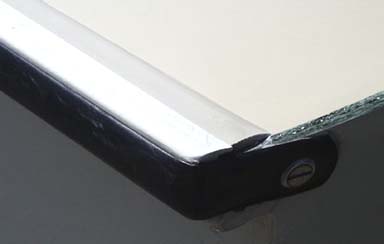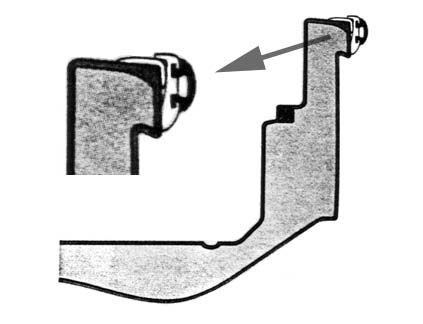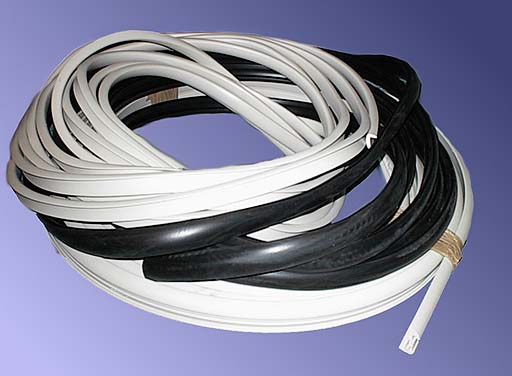
Three components: L-molding capping the hull-deck joint; receiver with track; rub rail insert. The rail runs completely around the hull in one piece, secured on each side with a screw.
Replacing the Rub Rails is one of the most common repairs on Boston Whalers. Twin Cities Marine is the best source for materials; see below for their information. If you have a pre-1970's boat, you may want to upgrade to the newer style rub rail. Refitting the Rub Rail will take about two to three hours and require just simple tools. The procedure is described below.
Boston Whaler boats have two distinct styles of rub railing. These are easily recognized; one was white: one was black.
The earliest Boston Whaler boats used a white rub rail which was retained by adhesive. This design was used until c.1972.
The original white one-piece rub rail which was used on the early Boston Whaler 13-foot boats and which is applied by using an adhesive is still available from CMI Marine. In 2010 the price was about $185 (for a 16-foot boat). Here is the contact information:
CMI MARINE 55 Woodrock Rd. Weymouth, MA 02189 Telephone: 781-337-0733 Fax: 781-337-0734
Boston Whaler offers a rub rail "Upgrade Kit" for older boats that adapts them to the newer style "two-piece" rub rail. (See below)
In 1999 Whaler produced the 40th Anniversary 13-foot Whaler model. This boat featured a white rub rail but using the 3-piece mechanically fastened components. Owners looking to restore a pre-70's 13-foot hull with a white rub rail could use this part as a replacement. (If anyone knows the Whaler part number please send it to me and I'll include it.) See Cetacea Page 51 for a 1959 13-Whaler restored with the newer white rub rail from Whaler.
Hamilton Marine sells an off-the-shelf rub rail that can be used.
In the early 1970's, Boston Whaler began using a new rub rail design. The new rub rail was known as a "two-piece" rub rail, although it often had three components: an L- molding (used on the 13 and 15), a white or Dessert Tan (to match hull color) receiver track, and a black rub rail. A red rub rail was used on a few models like the Outrages or a Newport in the 1970's for a year or two.
The advantage of the newer rub rail was the black rail portion could be more easily replaced if damaged. It was no longer necessary to remove the entire one-piece rail and glue on another. The railing was also heavier and more durable.
Here is an example of the rub railing on my own boat, a 1976 15 Sport. Because this rail is composed of three pieces, initially I wondered if the boat were in factory original condition, the rail always being referred to as a "two-piece" system. The outer two pieces seemed to be covering what looked like another original component. After finding a drawing (shown below) in a 1976 Boston Whaler catalogue that exactly matches my rub rail installation, I am convinced the rub rail is completely original.
 |
Rub Rail Three components: L-molding capping the hull-deck joint; receiver with track; rub rail insert. The rail runs completely around the hull in one piece, secured on each side with a screw. |
 |
|
Factory Rub Rail 1976 Whaler catalogue drawing of the rub rail detail, clearly showing the three components: L-molding, receiver track, and rail insert. |
It appears the L-molding is used on the 13-foot and 15-foot hulls as a shim to give the receiver track a better fit to the hull-deck joint. Without the shim, the lower edge of the receiver would hang below the hull-deck joint. Also, it is believed the L-molding and the receiver track were color matched to the hull, that is, both either white or Dessert Tan, although on my particular boat the L-molding is Dessert Tan and the receiver track is white. This may have resulted from a repair of the original in which the wrong color was used. The complete history of this particular boat is not known.
Based on field disassembly (by Kent Campbell), it appears the three piece rub rail system was installed at the factory as follows: The inner trim L-molding was not secured in place with adhesive, but was retained by the overlaying receiver track; the receiver was mechanically fastened to the hull with stainless steel screws on approximately six-inch centers; the railing was inserted into the receiver, wrapping around the boat from stern to stern and secured with screw fasteners at the transom ends.
Since the receiver track was not secured to the hull by use of a bedding compound or adhesive, removal of it for replacement is quite straightforward. There is no messy bedding or adhesive to clean up.
Incidently, the Boston Whaler installation installs the receiver track upside down, or at least upside down in terms of how the vendor imagined it being used.
Rub Rail kits from Boston Whaler cost about $100. A successful installer, Jack Deitrick, suggests:
The Boston Whaler supplied kit included pop-rivets, although you may want to opt for stainless steel screws, as they would make subsequent replacement easier by avoiding having to remove a zillion rivets.
If using rivets to attach the rub rail receiver track, the suggested rivet to use is an aluminum rivet, 3/16-inch diameter, 5/8-inch length. Drill a 3/16-inch hole for the rivets.
 |
|
Rub Rail Components The three components of the rub rail are seen here, stacked in coils. From top to bottom: the L-molding, the rub rail, and the receiver track. PhotoCredit: Sue Lodel, Twin Cities Marine |
The receiver and track components of the railing were made by:
BARBOUR PLASTICS, INC 932 North Montello Street, PO Box 2158 Brockton MA 02405 Phone: 508-583-8200 Fax: 508-583-4113
Barbour's two-piece Rigid/Flexible--that's what they call it--style rubrail was used by Whaler from c.1972-c.1993 on almost all boats except the 27-foot and 31-foot hulls. The "rigid" vinyl receiver section was usually white or desert tan (to match hull color) and the flexible insert was usually black, although red was used on early 19-foot and early Vee Outrages and Newports. It is believed this style comes in various sizes; the vendor may be able to help with the correct size used on a given Whaler. It is not known if they made the earlier one-piece white rubrail or if they are still furnishing rubrails to Whaler.
As used on the 13-foot hulls, the receiver track is their P/N R1078. The black insert is their P/N F878. The L-molding is not considered a standard piece, but rather a "custom" piece for Boston Whaler. (Information from Kent Campbell). It appears the L-shaped molding acts as a shim, for if it were not there, the rigid receiver would hang below the bottom edge of the fibreglass hull protusion. This may have been a adaptation by the factory to permit the product to be used on the smaller hulls where the hull-deck joint was not wide enough to accept the Barbour receiver.
Barbour really doesn't want to sell one- or two-foot pieces of rub rail directly to an end-user. You may have to purchase a long length (like 500-feet). It has been reported that they may have some pre-cut scrap lengths available at various times. It has been reported that as a manufacturer, they prefered to sell only in bulk to wholesalers or boat builders, and that in almost all instances they would refer inquiries to Boston Whaler for purchase, although several buyers have reported success in dealing directly with them. Your results may vary. Their pricing does not seem to be drastically different, and your easiest path may be to contact a Boston Whaler dealer.
If you are seeking a replacement for the red rub rail insert that was used on certain models of classic Boston Whaler boats in the late 1970's and early 1980's such as the NEWPORT, OUTRAGE 19, OUTRAGE V-20, OUTRAGE V-22, and REVENGE 19, the best known source is from Barbour Plastics. According to a very reliable informant, the red rub rail insert is their style F878 and they call the color "Scarlet". In January of 2004 they did not have this in stock and required a 500-foot order minimum.
Experience in obtaining the rub railing from a Boston Whaler dealer can vary, too, depending on how service- or parts-oriented your dealer is. If your local dealer is not interested in getting this for you, you can contact others who will help. The rub rail may be purchased in small quatities by the foot.
The part numbers, according to a reliable source, are as follows:
Three-piece Rub Rail Kit: 500-05005
Newer style "heavy duty" Rub Rail Kit: 500-05017
One Boston Whaler dealer with a parts department and willingness to provide rub rail materials is Twin Cities Marine, <tcmarine@lakefield.net>, TEL.: (920) 793-2715. Sue Lodel is their Parts Manager.
If there are other dealers who would like to be referenced in this article because they have rub rail replacement kits in stock and available, I would be glad to include them.
Reports from several purchasers indicate the rub rail materials can be obtained for approximately $100-$125.
DISCLAIMER: This information is believed to be accurate but there is no guarantee. We do our best!
Copyright © 1999, 2000 by James W. Hebert. Unauthorized reproduction prohibited!
This is a verified HTML 4.0 document served to you from continuousWave
URI: http://continuouswave.com
Last modified:
Author: James W. Hebert with important
contributions from others with attribution in the text.
This article first appeared May 30, 2000.